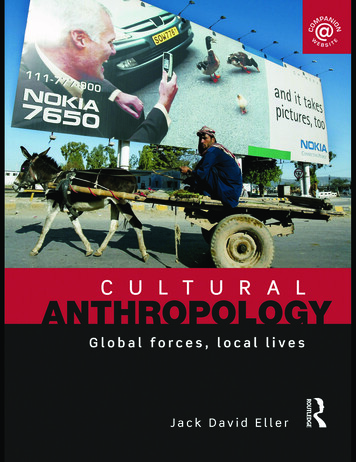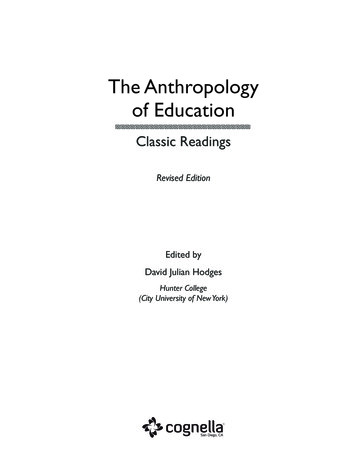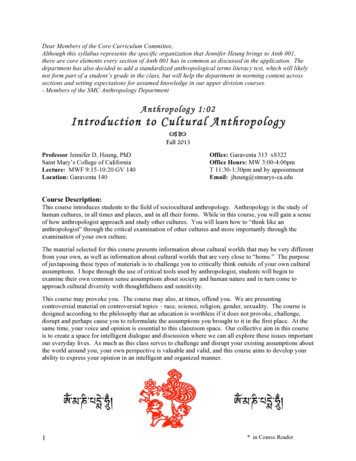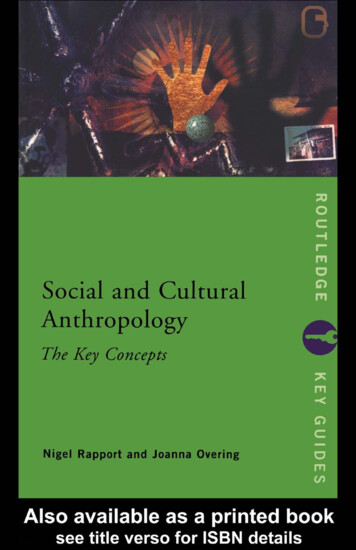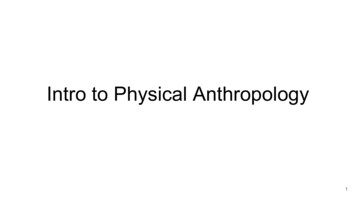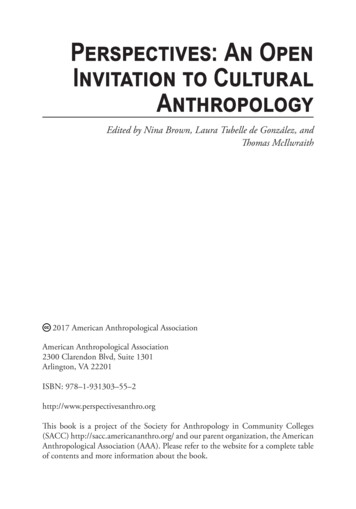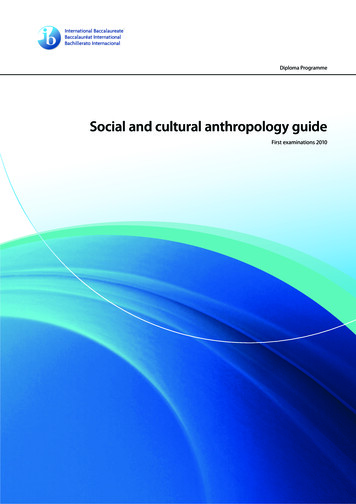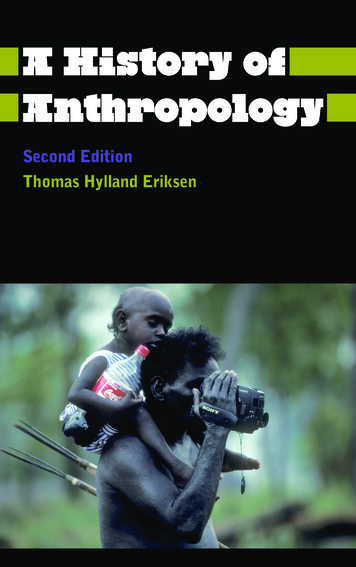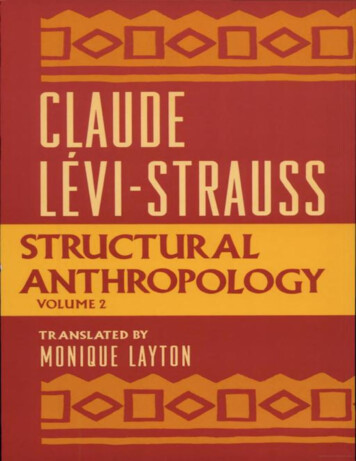
Transcription
CLAUDE LÉVI-STRAUSSStructural Anthropology VOLUME IITranslated from the French by Monique LaytonBASIC BOOKS, Inc., Publishers, New York
Library of Congress Cataloging in Publication Data (Revised)Lévi-Strauss, Claude.Structural anthropology.Vol. 2 translated by M. Layton Bibliography v. 1, p. 385-398; v. 2, p. 1.Structural anthropology.GN362.L4813 301.2 63-17344ISBN 0-465-08230-0 (v. 2)COPYRIGHT 1976 BY CLAUDE LÉVI-STRAUSS PRINTED IN THEUNITED STATES OF AMERICA76 77 78 79 80 10 9 8 7 6 5 4 3 2 1
To the members of the Laboratoire d'anthropologie socialeVos quoque pectoribus nostris haeretis, amici, dicere quos cupio nominequemque suo.Ovid, Tristia, III, iv.
— vii —Author's PrefaceAPPEARING FIFTEEN YEARS after Structural Anthropology, Volume I,this book remains faithful to the same formula: it brings together textswhich were written both before and after the publication of the first book.Some were written in French, others directly in English; almost all areimpossible to find today. They were so selected and ordered as to enable areader unfamiliar with the problems of modern ethnology to get a bird's-eyeview; to be introduced by means of a few representative examples gatheredin a single volume to the way structural anthropology tackles theseproblems and attempts to solve them.Part One, devoted to the past and future of the discipline, defines the fieldof anthropology and puts into proper perspective the questions it poses.In Part Two, examples illustrate the way to overcome some theoretical andpractical difficulties related to social organization and attitudes linked tokinship systems.Part Three is the most developed. In it I treat that domain which I have beenmost concerned with for the past twenty years: mythology and ritual. Iattempt to distinguish between structuralism— viii —and formalism from a theoretical point of view. Some concrete examplesare used to show how variants of one myth, or several myths which appeardifferent from one another, can be reduced to so many stages of the samegroup of transformations, as can their corresponding rituals among the sameor among different peoples. Finally, I illustrate the manner in which a mythcan degenerate into legendary tradition, romantic narrative, or politicalideology.
Part Four briefly reviews the various problems which our contemporarysocieties face in many areas: literature, fine arts, urban life. More attentionis given to the organization of research and teaching in the human andsocial sciences, and to certain obstacles, too often misunderstood orunderestimated, against what we call progress.This last part ends with the oldest text in this collection; a text published in1952 and reprinted several times, but presented here in a revised version.The very wide perspective enables one to use this text as a conclusion, sinceit examines the relations between race and history, on the one hand, and thequestion of nature and the meaning of progress, on the other.The most fashionable objection to structural anthropology is that itshypotheses cannot be "falsified." Yet, this criterion can only be applied tofully established sciences. Anthropology has not yet attained this stage. Nophysical or natural science could have come to maturity in the centuries ittook for them to develop if they had allowed themselves to be stopped bythis type of criticism.We may even wonder if this criterion of "falsifiability" can truly be appliedto human sciences. Their epistemological status is not at all like thosewhich the physical and natural sciences can claim for themselves. These arecharacterized by a harmony which at all times has reigned among thosewho practice them at the level considered relevant to the contemporary stateof the research. But such is not the case for those we call human sciences.With these, there is little or no discussion on the validity of such-and-suchhypothesis. The discussion bears instead on the choice of a certain level ofreference implied by this hypothesis, and not of another level which anopponent might favor.It is exceptional for structural anthropologists to be told:— ix —"Your interpretation of this phenomenon or group of phenomena is not theone which best accounts for the facts." Rather, they are told: "The way youbreak down the phenomena is not the way which interests us; we choose tobreak them down another way." The subject of the human sciences is man,
yet the man who studies himself as he practices the human sciences willalways allow his preferences and prejudices to interfere in the way hedefines himself to himself. What is interesting in man is not subject toscientific decision but results and always will result from a choice which isultimately of a philosophical order.So we must recognize that the hypotheses of the human sciences cannot,now or ever, be falsified. In this domain, a hypothesis is never true.Consequently, it cannot be false either. Let us rather say that, in the humansciences (and thus in anthropology), a hypothesis only possesses a relativevalue, granted if it succeeds in accounting for more facts than thosehypotheses it replaces; that is, until such times as another one makes a newstep in the same direction. Thus it is proper to locate structuralanthropology in relation to its predecessor and to those hypotheses whichwill one day replace it.The value of the epistemological model offered by structuralism to thehuman sciences cannot be compared to the models available so far.Structuralism uncovers a unity and a coherence within things which couldnot be revealed by a simple description of the facts somehow scattered anddisorganized before the eyes of knowledge. It also does this moreeconomically, with a very small number of principles, axioms, and ruleswhich, in a variety of domains, have proved their fecundity. Butstructuralism does not presume to contain the truth. It is content to say thatthings are a little clearer today than they were yesterday. While it hopes thatits efforts, surpassed by others, have contributed to the progress made byhuman sciences, it knows that the nature of its study is such that thisprogress has no conceivable end. It also knows that we will only be able toverify or falsify the hypotheses we use on that remote day (if it ever comes)when the natural sciences are able to reach those organic foundations forprogress which now we can only perceive as undefined and distortedreflections.Claude Lévi-Strauss
Translator's PrefaceI WISH TO THANK Heather Wagg, who collaborated with me throughmost of the translation, and Barry Pavitt, who assisted in its last stages. Mythanks are also due to Francis Levy and J. Powell, who kindly gave me theirhelp when I needed it.May I also express my gratitude to Professor Lévi-Strauss for his constantwillingness to clarify points obscure to me, and for his patient assistance.
ContentsAuthor's PrefaceTranslator's PrefaceList of FiguresPART ONE PERSPECTIVE VIEWSI The Scope of AnthropologyII Jean-Jacques Rousseau, Founder of the Sciences of ManIII What Ethnology Owes to DurkheimIV The Work of the Bureau of American Ethnology and Its LessonsV Comparative Religions of Nonliterate PeoplesPART Two SOCIAL ORGANIZATIONVI The Meaning and Use of the Notion of ModelVII Reflections on the Atom of KinshipPART THREE MYTHOLOGY AND RITUALVIII Structure and Form: Reflections on a Work by Vladimir ProppIX The Story of AsdiwalX Four Winnebago MythsXI The Sex of the Sun and MoonXII Mushrooms in Culture: Apropos of a Book by R. G. WassonXIII Relations of Symmetry Between Rituals and Myths ofNeighboring PeoplesXIV How Myths DiePART FOUR HUMANISM AND THE HUMANITIESXV Answers to Some InvestigationsXVI Scientific Criteria in the Social and Human DisciplinesXVII Cultural Discontinuity and Economic and Social DevelopmentXVIII Race and 198211222238256271288312323363373
List of Figures1.2.3.4.5.6.7.System of Lambumbu attitudes88System of Mundugomor attitudes91System of Lele attitudes101Lele marriage: First formula102Lele marriage: Second formula102Vertical exchange among the Lele106Vertical exchange among the Mundugomor107Relations between patrilateral marriage, double dichotomy, and sex8.111affiliation9. Map of Tsimshian territory15410. Skeena version of the alimentary opposition17911. Skeena alimentary system17912. Symmetrical relations between two versions of the same myth18813. Motif of forgetfulness in the Asdiwal myth19114. Triangular system of first Winnebago myth20115. Polar system of fourth Winnebago myth20616. Four myths forming a system21017. Symmetrical relations between Mandan and Hidatsa rites24918. Hard sciences, social and human sciences302
Chapter I: The Scope of AnthropologyChapter I was first presented as the inaugural address of the chair ofsocial anthropology and was delivered by the author at the College deFrance on January 6, 1960. It was first published by the Collège deFrance under the tide Chaire d Antropologie sociale: Leçon inauguralefait le 6 janvier 1960 par M. Claude Lévi-Strauss, Professor (Paris:Collège de France, 1960). No. 31.[Translator's note: A few sentences were borrowed from a previoustranslation of this address; see The Scope of Anthropology, trans. S. O.Paul and R. A. Paul (London: Jonathan Cape, 1967).]Mr. chairman,My dear colleagues,Ladies and gentlemen:It was a little over a year ago, in 1958, that the Collège de France decided toinstitute a chair of social anthropology. This science is so attentive to theforms of thought we call superstitious when we encounter them amongourselves that I may be allowed, I trust, an initial homage here tosuperstition. Is it not in the nature of myths, which play such an importantpart in our research,—4—to evoke a suppressed past and to apply it, like a grid, upon the dimensionsof the present, and to do this in the hope of finding some meaning wherebytwo confronting faces—historical and structural—of man's own reality willfor once coincide? On this occasion, in which I meet all the characteristicsof myth, may I also be allowed to proceed on the example of myth—seeking in some past events the meaning and the lesson of the honoraccorded me? The very date of your deliberation, my dear colleagues—bythe strange recurrence of the number 8 already well known fromPythagorean mathematics, the periodic table of chemical elements, and thelaw of symmetry of the jellyfish—bears witness that the proposal, in 1958,
to create a chair of social anthropology re- news a tradition from which thisspeaker, had he even wished to, would have been powerless to escape.Fifty years before your initial decision, Sir James George Frazer deliveredat Liverpool University the inaugural lecture of the first chair in the worldto be given the title of social anthropology. Fifty years earlier, in 1855—justover a century ago— Franz Boas and Émile Durkheim were born, two menwhom posterity will regard as, if not the founders, at least the masterbuilders (one in America and the other in France) of anthropology as weknow it today.It is appropriate that these three anniversaries, these three names, be evokedhere. Those of Frazer and Boas give me the opportunity to attest, if onlybriefly, to all that social anthropology owes to Anglo-Saxon thought and towhat I owe to it personally, since my first works were conceived anddeveloped in close collaboration with it. But it should not come as asurprise that Durkheim occupies a larger place in this address: Heincarnates the essence of France's contribution to social anthropology,although his centenary—lavishly celebrated in many foreign countries—passed almost unnoticed here and has not yet been marked by any officialceremony. 1How can we explain this injustice done to him (an injustice also toourselves), if not as a minor consequence of this passion which moves us toforget our own history and even to hold it "in horror," in the words ofCharles de Remusat—a sentiment which leaves social anthropology indanger of "losing" Durkheim as it has already lost Gobineau andDémeunier.—5—And yet, my dear colleagues, those among you who share these distantmemories with me will not contradict me when I recall that, around 1935,when our Brazilian friends wanted to explain to us why they were moved tochoose French missions to form their first universities, they alwaysmentioned two names: first, of course, the name of Pasteur, and next, thename of Durkheim.
But in reserving these thoughts for Durkheim, we perform another duty. Noone would have been more sensitive to homage such as this than MarcelMauss, a pupil of Durkheim and later his successor. From 1931 to 1942, atthe Collège de France, Marcel Mauss held a chair devoted to the study ofsociety. So brief was his stay in these halls of the unfortunate MauriceHalbwachs that one could truthfully assume that, by creating a chair ofsocial anthropology, it is Mauss's chair you want to restore. This speaker, atleast, owes too much to Mauss's thought not to relish this speculation.The chair was entitled "Sociology" because Mauss, who, with Paul Rivet,worked so hard to make ethnology a science in its own right, had not quiteachieved this by 1930. But to attest to the continuity between our teachings,it will suffice to recall that ethnology assumed an ever increasing place inMauss's work; that, as early as 1924, he proclaimed the "place of sociology"to be "in anthropology"; and that—if I am not mistaken—Mauss was thefirst to introduce, in 1938, the words "social anthropology" into Frenchterminology. He would not disavow them today.Even in his boldest proceedings, Mauss never felt that he was straying fromthe Durkheimian line. Today we can, perhaps, perceive better than he how,without betraying an oft-affirmed loyalty, he simplified his greatpredecessor's doctrine and rendered it more tractable. This doctrine has notceased to astonish us by its imposing proportions, its powerful logicalframework, and the vistas it opens onto horizons where so much is yet to beexplored. The mission of Mauss was to complete and fit up the prodigiousedifice conjured from the earth at the passage of the demiurge. He had toexorcize a few metaphysical ghosts who were still trailing their chainsthere, and the edifice had to be shielded once and for all against the icywinds of dialectic, the thunder of syllogisms,—6—the lightning flashes of antinomies. But Mauss protected Durkheim'sschool from yet other dangers.Durkheim was probably the first scholar to introduce this requirement forspecificity into the sciences of man. He thereby opened the way for arenovation, at the beginning of the twentieth century, from which most
sciences benefited, particularly linguistics. In any field of human thoughtand activity, one cannot ask questions regarding nature or origin beforeidentifying and analyzing phenomena, and discovering in what measure therelations uniting such phenomena are sufficient to explain them. It isimpossible to discuss an object, to reconstruct the process from which itarose, without knowing first what it is; in other words, without havingexhausted the inventory of its internal determinants.Yet, on rereading today The Rules of Sociological Method (Durkheim1964), one cannot help but think that Durkheim has applied these principleswith some partiality. He refers to them in order to constitute the social as anindependent category, but without taking heed that this new category entailsall sorts of specificities corresponding to the various aspects through whichwe apprehend it. Before maintaining that logic, language, law, art, andreligion, are projections of the social, would it not have been wise to waituntil the particular sciences had thoroughly examined the mode oforganization and the differential function of each of these codes, thusfacilitating the understanding of the nature of their interrelations?At the risk of being accused of paradox, it seems to us that in the theory ofthe "total social fact" (so often praised, yet so little understood), the notionof totality is less important than the very particular manner in which Maussconceives it. It is a foliated conception, one might say, composed of amultitude of distinct and yet joined planes. Instead of appearing as apostulate, the totality of the social is manifested in experience—a privilegedinstance which can be apprehended on the level of observation, in welldefined situations, and in which "the totality of society and its institutions .is set in motion." But this totality does not suppress the specific character ofphenomena, which remain, as Mauss says in The Gift (Mauss 1969), "atonce juridical, economic, religious, and even aesthetic, morphological."Thus totality resides finally in the network of functional interrelationsamong all these planes.This empirical attitude taken by Mauss explains how he so—7—
quickly overcame that distaste that Durkheim initially felt towardethnographic investigations. "What counts," said Mauss, "is the Melanesianof such and such island." Against the theoretician, the observer shouldalways have the last word, and against the observer, the native. Finally,beneath the rationalized interpretations of the native—who is often observerand even theoretican of his own society—one must seek the "unconsciouscategories" which, as Mauss wrote in one of his first works, aredeterminants "in magic, as in religion, as in linguistics." Withoutcontradicting Durkheim (since it was to be on a new plane), this analysis indepth was to enable Mauss to reestablish ties with other sciences of manthat had at times been unwisely severed: with history, since theethnographer sets up camp in the particular, and also with biology andpsychology, once social phenomena are recognized as being "first social,but also, and at the same time, both physiological and psychological." Itwill be sufficient, Mauss said, to take the analysis to a level where "body,soul, society, everything merges."This lush sociology examines men as depicted by the travelers and theethnographers who shared their existence, in either a fleeting or a lastingmanner. It shows them engaged in their own historical development and setin a definite geographical space. It has, says Mauss, "as principle and asgoal . to perceive the entire group and the entire range of its behavior."If disembodiment was one of the perils facing Durkheimian sociology,Mauss protected it with equal success against another danger: automatism.Too often since Durkheim—and even among some who believedthemselves liberated from his doctrinal domination—sociology hasappeared as the product of a hasty foray into history, psychology,linguistics, economics, law, and ethnography. Sociology was content to addits recipes to the fruits of this plunder. Whatever the problem submitted toit, one could be assured of receiving a prefabricated "sociological" solution.If we have left this stage behind, we owe it in great part to Mauss, and toMalinowski, whose names must be associated. At the same time, and nodoubt aided by one another, they showed (Mauss as a theoretician,Malinowski as an experimenter) what the administration of proof canamount to in the ethnological sciences. They were the first to understand
clearly that it is not enough to break down and to dissect. Social facts arenot reducible to scattered—8—fragments: they are lived by men, and this subjective consciousness is asmuch a form of their reality as objective characteristics.While Malinowski was instituting the ethnographer's uncompromisingparticipation in native life and thought, Mauss was affirming that what isessential "is the movement of the whole, the living aspect, the fleetingmoment in which society, and men become sentimentally conscious ofthemselves and of their situation vis-à-vis others." This empirical andsubjective synthesis offers the only guarantee that the preliminary analysis,carried as far as the unconscious categories, has allowed nothing to escape.Without a doubt, the test will remain largely illusory. We shall never knowwhether the other person—with whom, after all, we cannot identifycompletely—makes from elements of his social existence a synthesis thatcan be exactly superimposed on the one we elaborate. But one need not goso far. It is enough—and for that the inner feeling is sufficient—that thesynthesis, even approximate, arises from human experience. We must makesure of it, since we study men, and as we are ourselves men, we have thatcapability. The manner in which Mauss poses and resolves the problemin The Gift enables one to see, in the intersection of two subjectivities, thenearest order of truth to which the sciences of man can aspire when theyconfront the integrity of their object.Let us make no mistake: All this, which seems so new, was implicitlypresent in Durkheim. He has often been reproached for having formulated,in the second part of The Elementary Forms of the Religious Life (1968), atheory of religion so vast and so general that it seemed to rendersuperfluous the minute analysis of Australian religions which preceded itand—one would have hoped—paved the way for it.The question is whether Durkheim the man could have arrived at this theorywithout being forced, at the outset, to supersuper upon the religiousrepresentations received from his own society those of men whom historical
and geographical evidence guaranteed to have been integrally "others," andnot accomplices or unsuspected acolytes. Indeed, such is the way theethnographer proceeds when he goes into the field, for however scrupulousand objective he may want to be, it is never himself, nor is it the otherperson, whom he encounters at the end of his investigation. Bysuperimposing himself on the other, he can at most claim to extricate—9—what Mauss called facts of general functioning, which he showed to bemore universal and to have more reality.In thus completing what Durkheim envisioned, Mauss freed anthropologyfrom the false dichotomy, introduced by thinkers such as Dilthey andSpengler between explanation in the physical sciences and explanation inthe human sciences. The search for causes ends with the assimilation of anexperience, but an experience at once external and internal. The famous ruleto "consider social facts as things" corresponds to the first step, which thesecond step is left to validate. We can already discern the originality ofsocial anthropology. Instead of opposing causal explanation andunderstanding, it brings to light an object which may be at the same timeobjectively very remote and subjectively very concrete, and whose causalexplanation could rest upon that understanding which is, for us, but anadditional form of proof. A notion such as empathy inspires great mistrustin us, with what it implies of compounded irrationalism and mysticism. Inhis demand for supplementary proof, we rather imagine the anthropologistas modeled after the engineer, who conceives and constructs a machine by aseries of rational operations; it has to work, however, and logical certaintyis not enough. The possibility of trying the intimate experience of "theother" with oneself is but one of the means available for obtaining this finalempirical satisfaction for which both physical and human sciences feel aneed, less a proof, perhaps, than a guarantee.What, then, is social anthropology?Although he did not specifically name it, Ferdinand de Saus-sure came veryclose to defining it when he introduced linguistics as part of a science yet tobe born, for which he reserved the name "semiology." Its object of study he
saw to be the life of signs at the heart of social life. Did he not, furthermore,foresee our adherence when he compared language to "writing, to thealphabet of deaf-mutes, to symbolic rites, to forms of politeness, to militarysignals, etc."? No one would deny that anthropology includes in its ownfield at least some of these systems of signs, to which it adds many others,such as mythical language, the oral and gestural signs of which ritual iscomposed, marriage rules, kinship systems, customary laws, and certainforms of economic exchange.We conceive anthropology as the bona fide occupant of that— 10 —domain of semiology which linguistics has not already claimed for its own;and this until the time when, at least for some sections of this domain,special sciences are set up within anthropology.However, this definition must be made more precise in two ways.First of all, one quickly recognizes that some of the subjects which havejust been cited already belong within particular sciences, such aseconomics, law, political science. However, these disciplines addressthemselves to the facts closest to us, which consequently have for us aprivileged interest. Let us say that social anthropology apprehends themeither in their most remote manifestations or from the angle of their mostgeneral expression. From this latter point of view, anthropology can donothing useful without close collaboration with the particular socialsciences. But these sciences could not aspire to generality without thecooperation of the anthropologist, who alone can provide relativelycomplete accounts and inventories.The second difficulty is more serious. One may question whether all thephenomena of interest to social anthropology can actually be characterizedas signs. This is sufficiently clear for the problems which we study mostfrequently. When we consider some system of belief (let us say totemism)or some form of social organization (unilineal clans, bilateral cross-cousinmarriages), the question we ask is "What does it all mean?" To answer it,
we attempt to translate into our language rules originally conceived inanother language.But is this true of other aspects of social reality, such as implements,techniques, and modes of production and consumption? It would seem thatwe are concerned here with objects, and not with signs—the sign being,according to Peirce's famous definition, "that which replaces something forsomeone." What, then, does a stone axe replace, and for whom?The objection is valid up to a certain point, and it explains why some arereluctant to include in the field of social anthropology phenomena related toother sciences, such as geography and technology. The term "culturalanthropology" is thus appropriate to distinguish this part of our studies andstress its originality.But it is well known—and it was one of Mauss's claims to fame to haveestablished this in agreement with Malinowski—— 11 —that, particularly in the societies with which we are concerned, but in othersas well, these domains are pregnant with meaning. From this point of view,they already concern us.Finally, the exhaustive aims which inspire our investigations greatlytransform their object. Techniques taken in isolation may appear as rawfact, historical heritage, or the result of a compromise between human needsand the constraints of environment. But when one places them in thatgeneral inventory of societies which anthropology attempts to construct,they come out in a new light, For then we envisage these techniques as theequivalents of so many choices, from all the possible ones which eachsociety seems to make. (This is a convenient language which must bestripped of its anthropomorphism.) In this sense, it is conceivable that astone axe could be a sign. In a given context, and for the observer capableof understanding its use, it stands for the different implement which anothersociety would use for the same purpose.
Consequently, even the simplest techniques of any primitive society take onthe character of a system that can be analyzed, in terms of a more generalsystem. The techniques can be seen as a group of significant choices whicheach society—or each period within a society's development—has beenforced to make, whether they are compatible or incompatible with otherchoices.In positing the symbolic nature of its object, social anthropology does notintend to cut itself off from realia. How could it, when art, in which all issign, utilizes material media? One cannot study gods while ignoring theirimages; rites without analyzing the objects and substances manufacturedand manipulated by the officiant; or social rules independently of the thingswhich correspond to them. Social anthropology does not confine itself to apart of the domain of ethnology; it does not separate material culture andspiritual culture. In its own perspective—which we shall have to define—itis equally interested in each. Men communicate by means of symbols andsigns. For anthropology, which is a conversation of man with man, allthings are symbol and sign which act as intermediaries between twosubjects.By this deference toward objects and techniques, as well as by our certaintyof working on meanings, our conception of social anthropology leads usnoticeably away from Radcliffe-Brown— 12 —who—until his death in 1955—did so much to give autonomy to ourinvestigations.According to the views (always wonderfully clear) of this English master,social anthropology would be an inductive science which, life othersciences of this type, observes facts and formulates hypotheses which canbe submitted to experimental control in order to discover the general lawsof nature and society. It thus sets itself apart from ethnology, which attemptsto reconstruct the past of primitive societies—but by such precarious meansand methods that social anthropology can learn nothing from it.
When this inductive conception, inspired by Durkheim's distinctionbetween circumfusa and praeterita, was first formulated about 1920, itmarked a healthy reaction against the excesses of the diffusionist school.But since then, "conjectural history" (as Radcliffe-Brown called it, notwithout some contempt) has perfected and refined its methods, thanksnotably to stratigraphie excavations, to the introduction of statistics inarchaeology, to the analysis of pollens, to the use of carbon 14, ande
in a single volume to the way structural anthropology tackles these problems and attempts to solve them. Part One, devoted to the past and future of the discipline, defines the field of anthropology and puts into proper perspective the questions it poses. In Part Two, exa
